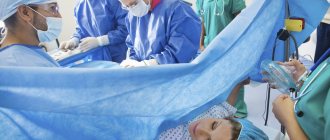Is pregnancy possible after curettage?
Is it possible to get pregnant after cleansing? Cleaning or curettage is a surgical intervention during which a specialist removes all the contents of the organ and its mucous layer from the uterine cavity. This procedure is shown:
- after a miscarriage or pregnancy that ended in fetal death;
- in case of significant defects of the child;
- if you need to eliminate an unexpected pregnancy;
- after a difficult delivery;
- for some gynecological diseases.
Since such surgical manipulation does not contribute to reproductive dysfunction, a woman can become pregnant again.
This procedure makes the endometrium much thinner and injures the uterine cavity, which must be taken into account when planning conception. In addition, cleansing can lead to hormonal imbalance, and it takes time to normalize. All this significantly complicates the process of bearing a fetus.
For a normal pregnancy, after curettage you need to undergo a thorough examination and consult with an experienced specialist about conception. The reason for which the manipulation was carried out and the lady’s condition will be taken into account.
What to do if there were several undeveloped pregnancies in a row?
When the death of the embryo occurs two or more times in a row, we are talking about pathological miscarriage. A kind of “chain reaction” occurs - a woman loses her child even after completing the entire rehabilitation course, most often in the same month. The body is configured to reject the embryo, and it dies even when doctors try to maintain the pregnancy. This does not mean that a woman who has experienced personal tragedy many times has no chance of bearing a fetus, but with each unsuccessful pregnancy they decrease. However, don't despair.
Such an anomaly is difficult to cure, but if a couple wants to have children, they should undergo examination and not ignore the recommendations of doctors. The patient will have to struggle with the reasons not only for the embryo dying, but also for miscarriage. You can’t rush into pregnancy - you need to plan it carefully, doing tests for sexually transmitted infections, determining the presence of antibodies to viruses and undergoing immunological studies. The period between frozen pregnancy and subsequent conception should be increased as much as possible.
READ ALSO: Is it possible to take Metypred in the early stages of pregnancy?
Many gynecologists claim that if a woman has several miscarriages in a row, this is due to genetic abnormalities. Sometimes doctors advise not to make any more attempts to conceive in order to preserve the woman’s health, and to direct energy to finding a baby for adoption or a surrogate mother.
Consequences for pregnancy?
Curettage is a stressful condition for the body physically and emotionally. Sometimes it is possible to form specks that will prevent subsequent pregnancy. A woman may become infertile.
To prevent such serious consequences, you should think 100 times before doing this operation. If there is no other way out, then it is important to choose a qualified specialist with extensive experience. The woman must first undergo diagnostics.
After cleaning you need:
- follow all medical instructions;
- visit a gynecologist regularly;
- be examined before planned conception;
- undergo a therapeutic course that will eliminate the development of the inflammatory process;
- forget about physical activity for at least six months;
- don't have sex for a month;
- use protection for the period specified by the doctor so that conception does not occur (the body needs rest and time to recover).
Any deviation after curettage may cause a lack of pregnancy in the future, so at the first discomfort you should consult a gynecologist.
Postoperative rehabilitation
Rehabilitation after curettage is very important and allows you to eliminate the likelihood of complications and speed up the recovery period. Immediately after curettage it is recommended:
Avoid physical activity for up to six weeks;
Establish sexual rest for up to a month to prevent the penetration of infections;
Take hormonal contraceptives for a period of up to three months, which will allow the reproductive system to rest and recover;
Conduct follow-up examinations with a gynecologist and ultrasound examinations to exclude postoperative complications.
The curettage procedure has been worked out by doctors to the smallest detail. However, like any surgical intervention, it does not exclude complications. A woman needs to carefully monitor her health and if the slightest deviation occurs, consult a doctor.
Medical assistance after curettage is required:
With a prolonged increase in temperature;
If the pain in the lower abdomen and lumbar region does not go away;
In case of unnatural discharge and bleeding;
In the absence of menstruation for two months.
Treatment after curettage may include:
Antibiotic therapy in the form of Doxycycline, Azithromycin, Trichopolum, Macropen to avoid possible inflammatory processes;
Taking hemostatic drugs such as Dicinone, Vikasol, Calcium chloride;
Antiviral treatment with Aciclovir;
Taking hormonal medications such as Duphaston;
For the treatment of psycho-emotional states, sedative medications and antidepressants are used in the form of Phenazepam, Adaptol, Melitor, Fluoxetine.
Features of pregnancy and childbirth after cleansing
Women who have previously undergone uterine cleansing need to be especially careful during pregnancy.
If a woman did not wait long and became pregnant immediately after curettage, she risks losing the baby or getting placenta previa. This is due to the fact that the endometrium did not have time to recover after surgery. Such women are usually under the supervision of a doctor all the time and can be hospitalized for a long time. The doctor must prescribe maintenance medications.
If the girl did not give birth and had a cleaning done, the uterine cervix could be injured. In this regard, she will not be able to hold the growing fetus, which will lead to a miscarriage. In such cases, the cervix is sutured before delivery.
Some ladies cannot psychologically come to terms with the loss of the previous heir (if the reason for the purge was a miscarriage or missed pregnancy). Constant worries keep the uterus in good shape, which can also lead to the loss of the child. Here you will need the help of a psychologist and the support of loved ones.
To make pregnancy and childbirth as successful as possible, you need to:
- eat a balanced diet;
- walk more in the fresh air;
- do not rush to get pregnant after curettage;
- do not lift heavy things;
- be less nervous;
- take vitamins;
- Take any medications in consultation with your gynecologist;
- at the first deviation, go to the hospital.
Why is curettage done and how does it happen?
Curettage of the uterus is a gynecological procedure during which its contents, including the superficial mucous layer, are removed. Cleaning is carried out in a hospital setting using local or general anesthesia. Curettage is considered a full-fledged surgical operation that requires appropriate preparation.
Before the procedure, the doctor must know exactly the purpose of curettage and the presence of contraindications to the operation in the patient. Cleaning is carried out using special gynecological instruments: vaginal speculum, blunt and sharp curette, uterine probe, dilators for the cervix, etc.
Before the manipulation, the patient is given anesthesia, the external genitalia are treated with an antiseptic solution, then curettage is performed. At the end of the procedure, the tissues are again treated with antiseptics, and the doctor places ice on the lower abdomen for better contraction of the uterus.
Cleaning has the following goals:
- artificial termination of an unplanned pregnancy;
- removal of the fertilized egg due to a frozen pregnancy;
- removal of fetal remains after spontaneous miscarriage;
- stopping uterine bleeding - metrorrhagia;
- incomplete separation of the placenta after childbirth;
- pathologies of the cervix;
- endometriosis, adhesions.
Uncomplicated curettage of the uterine cavity does not have a negative impact on a woman’s reproductive capabilities.
When is the best time to plan a pregnancy?
When can you get pregnant after cleaning the uterus? It is not recommended to think about conceiving immediately after cleansing. It takes 6-12 months to restore the wound surface, hormonal and emotional background. It is also important to understand and eliminate the reason for which the operation was performed. All negative factors should be removed in advance.
- If curettage was done for the purpose of abortion associated with an unplanned pregnancy, then the woman needs at least 3 months, sometimes six months or more, to recover. This directly depends on how long the cleaning took place. If the period is significant, then the thinning of the mucous membrane is severe. If you do not give her the opportunity to recover, the fertilized egg may attach outside the uterus or there will be a placental presentation.
- If polyps were removed from the uterine cavity, then you can think about conception within a couple of months, since a small area of the endometrium was affected. During this time, a histological examination of the obtained material will be performed. If the tumor is malignant, then you will have to forget about pregnancy during treatment. This may take 1 year or more.
- It will not be possible to get pregnant immediately after a cleansing, which was done for hyperplasia or endometriosis, or rather, it is undesirable. You need to wait for the mucous membrane to recover for six months or more, because after such a surgical intervention there is a significant wound surface.
- If the reason for cleaning is a spontaneous miscarriage or a frozen pregnancy, then before planning a subsequent one, you need to be thoroughly examined. After eliminating the cause and thoroughly treating all dysfunctions, we can talk about conception. After curettage, at least six months should pass. Considering that treatment of serious pathologies sometimes takes more than one year, women usually become pregnant after 1-5 years.
- Postpartum curettage depletes the female body. For everything to return to normal, you need to wait at least 1-1.5 years.
You need to think about pregnancy when not only physical recovery has occurred, but also emotional recovery. If a woman’s psyche is not stable, nervous breakdowns are often observed or, on the contrary, passivity, then you first need to visit a psychotherapist. Hormonal levels are important. It takes at least 6 months to recover. You should also take into account the individual characteristics of each woman. If six months is enough for one, then even a year will not be enough for the other.
Indications for mini-abortion
Vacuum aspiration is performed up to 5 actual weeks of pregnancy (or up to 21 days of missed menstruation). When performing a mini-abortion, the embryo along with the membranes is removed from the uterus using an electric pump and a special cannula. Cervical dilatation is not performed. The effectiveness of the method is up to 99%. After the procedure, an ultrasound scan is required to exclude retention of parts of the fertilized egg in the uterus.
Mini-abortion is carried out at the request of the woman, as well as in the presence of medical and social indications. Medical indications include fetal anomalies, non-developing pregnancy, and severe maternal illness. The operation is performed under general or local anesthesia.
Conclusion
Pregnancy after uterine cleansing should always be planned in advance. You cannot rush in such a matter, because the body must recover both physically and psychologically. Before conception, it is advisable to consult a gynecologist, be examined and cure all pathologies that will interfere with fertilization and gestation.
It is important to listen to the advice of your doctor, because an ill-considered pregnancy can result in a miscarriage or premature birth with fetal death. It is important to eliminate the cause of the previous miscarriage (if there was one).
Complications
- Perforation of the uterine wall;
- Infection into the uterine cavity;
- Remains of the fertilized egg, pathological formation in the uterus (depending on why the manipulation was used);
- Damage to the growth layer of the endometrium.
Hysteroscopy, although not necessary, is very important when the reason for curettage is the removal of a fertilized egg or pathological formation. Since it allows you to look into the uterine cavity after cleaning and see the presence of residues of one thing or another.
Curettage is performed blindly, so the use of hysteroscopy allows one to immediately exclude one of the complications.








